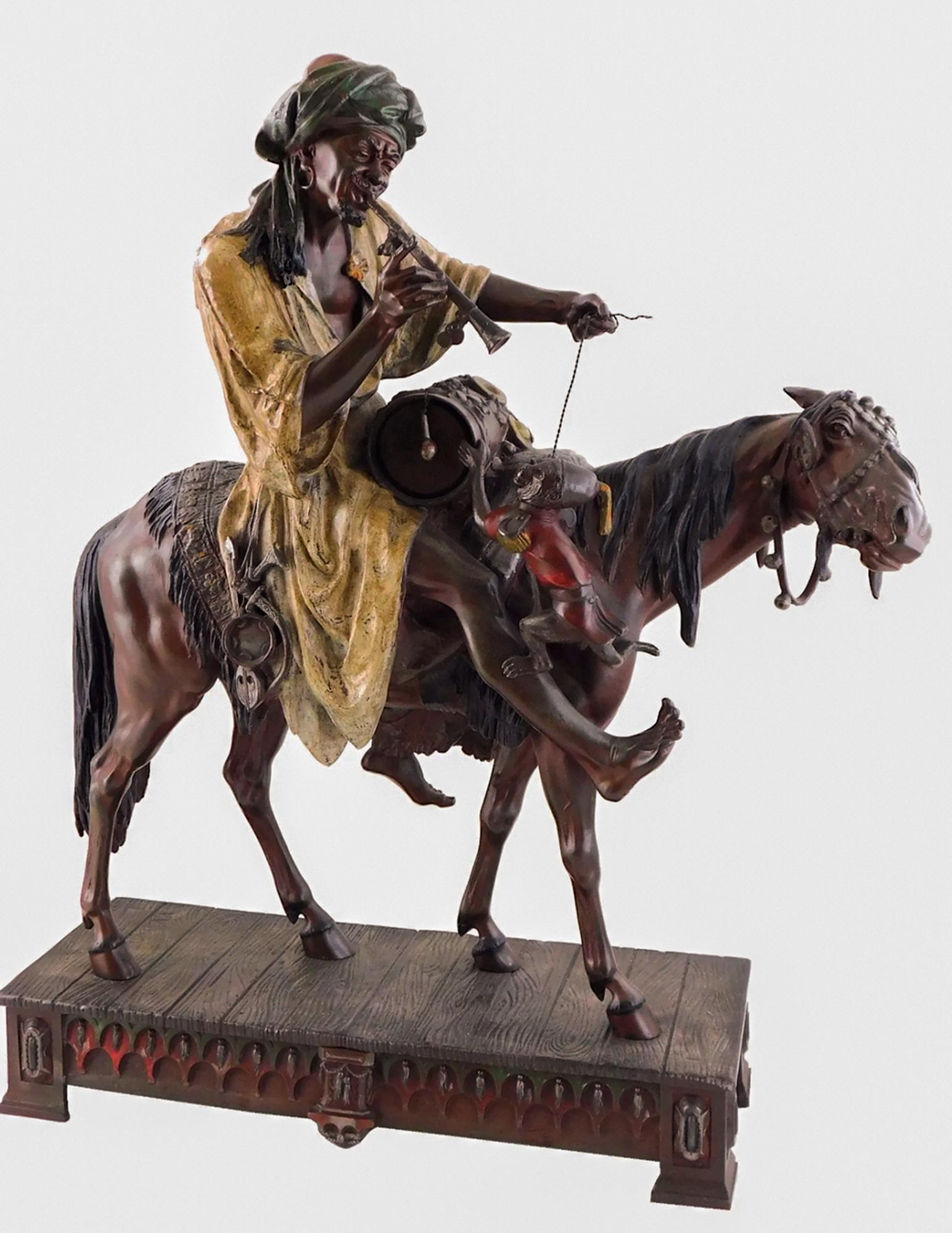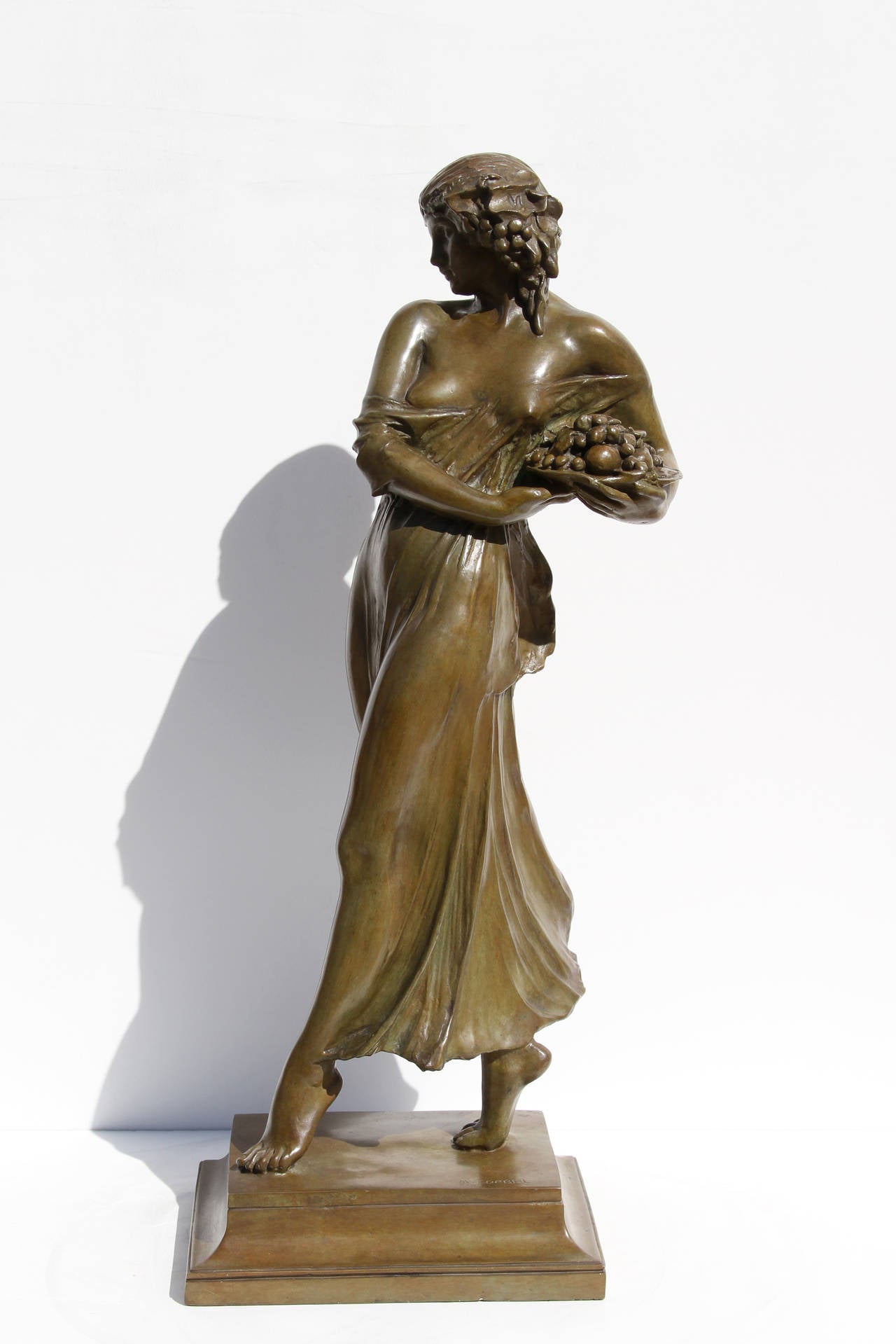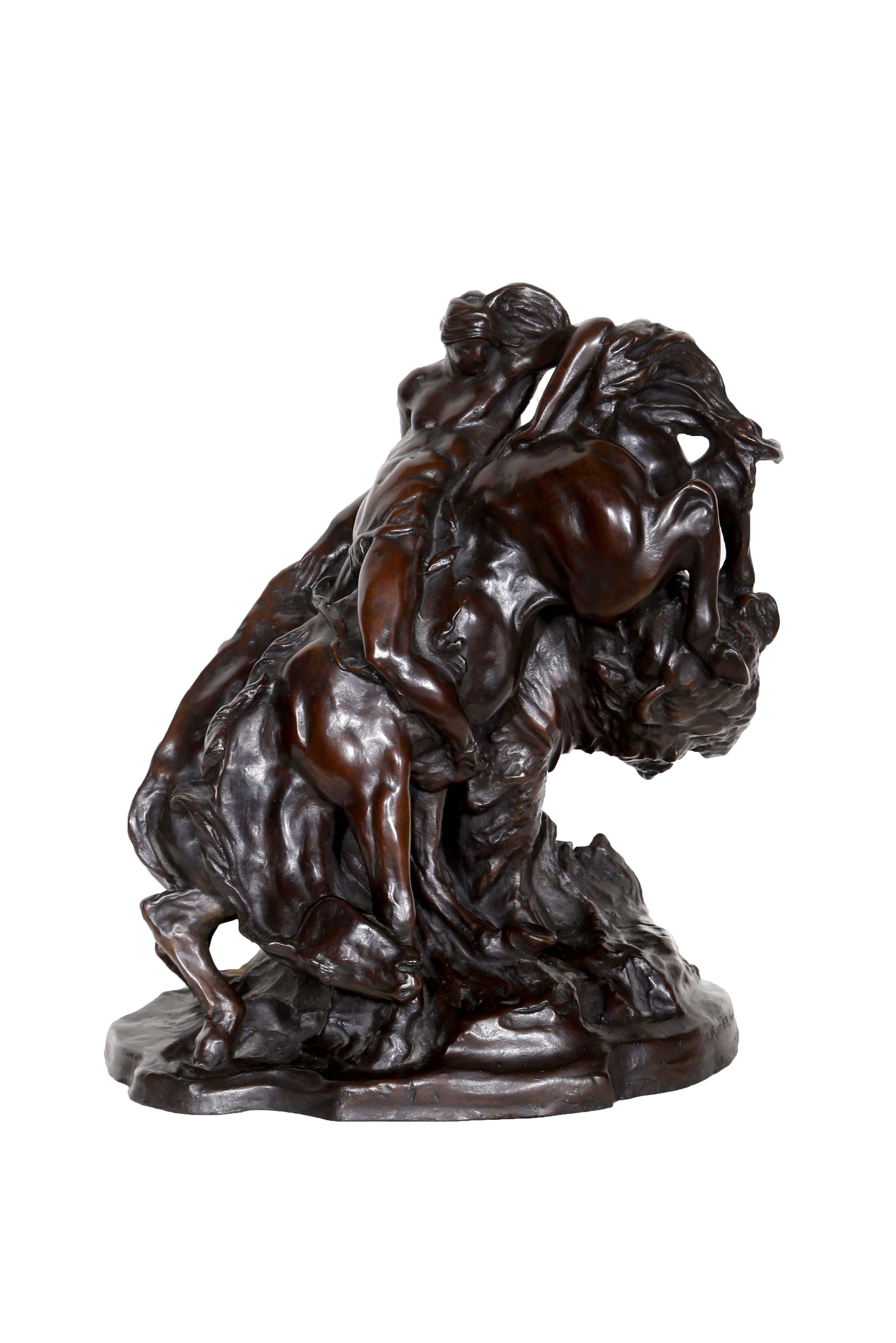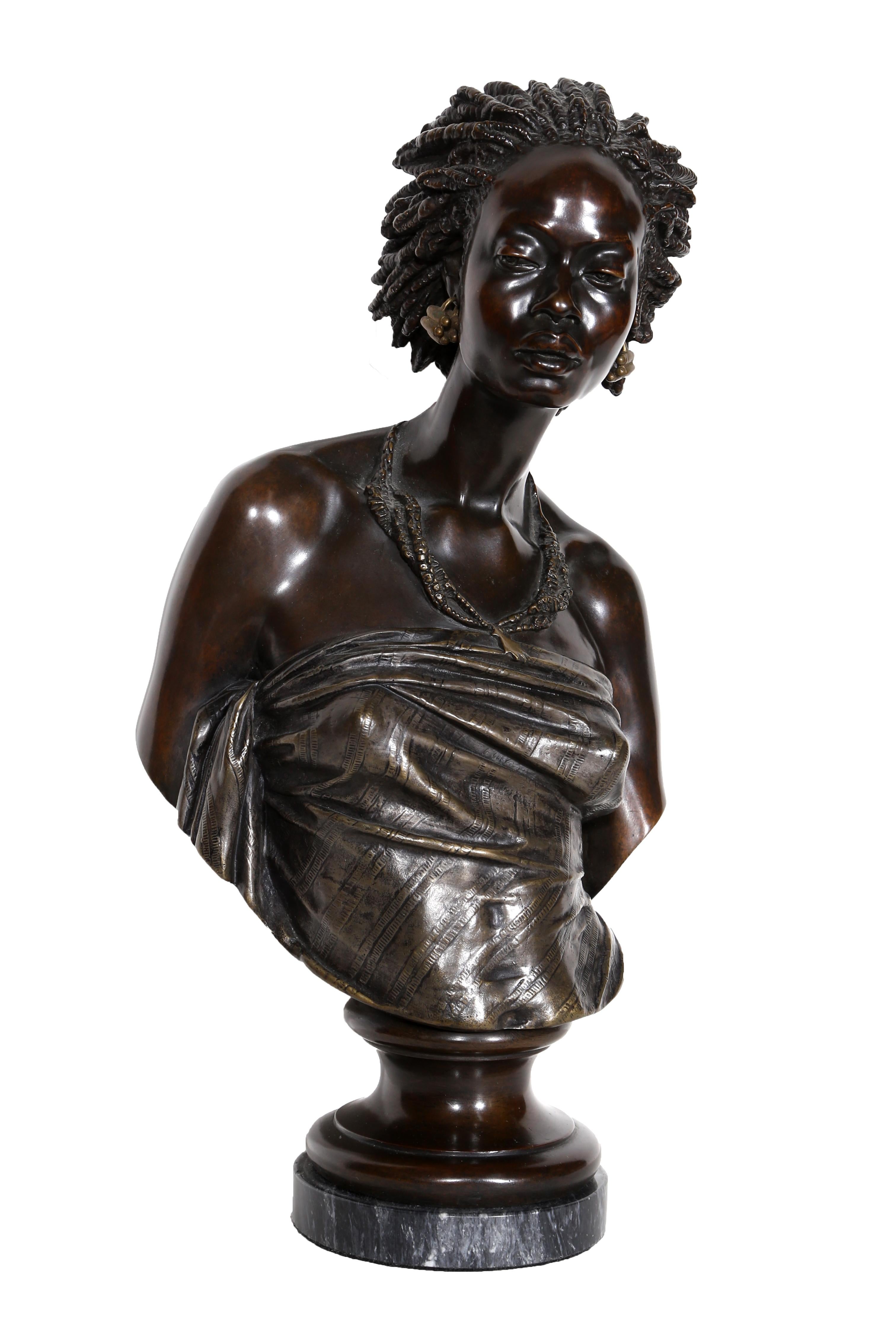Items Similar to Antique Bronze Miniature Barnyard with a Bull, Sheep & Goat circa 1860, France
Want more images or videos?
Request additional images or videos from the seller
1 of 13
Christophe FratinAntique Bronze Miniature Barnyard with a Bull, Sheep & Goat circa 1860, FranceCirca 1860
Circa 1860
About the Item
Antique Bronze Miniature Barnyard Scene (Cow, Sheep & Goat)
Christophe Fratin (France, 1801-1864)
Sand cast bronze
5 3/4 x 4 1/4 x 2 1/4 inches
Highly refined and sensitively modeled miniature bronze representing a small herd of cattle, sheep and cattle on the terrace. Despite its small size, this bronze offers a complete view of a small herd of livestock: a bull is lying in a landscape near a sheep and a goat climbing a tree above a rocky mound. Here we find the skillful hand of the animalier sculptor Christophe Fratin (French, 1801-1864), immensely famous in the 19th century for his thoughtfully crafted animal subjects as well as for his humorous anthropomorphic scenes. Resting on a small terrace, the artist with great mastery and realism describes a rural scene where the three animals have an attitude close to that in which we could meet them in nature. The sand cast fabrication and the carving are of very fine quality. Fratin has been able to render the texture of the animals' fur, the details are finely modeled in this miniature work. The superb patina is a warm dark to slightly golden brown. The bronze is signed on the terrace at the foot of the rocky mound with the famous signature of Fratin including his trademarked inverted "N."
Christophe Fratin, a native of Metz, first apprenticed with his taxidermist father until 1821, after which he shifted to a career in sculpture. Fratin was a highly skilled artist and one of the first of the French sculptors, along with Antoine Louis Barye, to successfully portray animals in bronze. His understanding of animal anatomy as well as their natural actions and poses infuse his bronzes with a life-like realism. Most of his animal subjects were modeled as what they would have looked like in their natural environment as opposed to the over-fed zoo animals that were created by so many other artists. Fratin's true understanding of animal anatomy and form came from his early experiences helping his father with his taxidermy business.
In Metz, he studied with sculptor Charles Augustin Pioche (1762-1839), until he tired of the Romantic style of the day. Afterwards, he went to Paris to work in the studio of Théodore Gericault, the only master he listed in the entries for his works in the Salon catalogues of the 1860s. In the Salon of 1831, he made his debut with wax models of a thoroughbred horse and several dogs, ushering in with another debutant, Antoine-Louis Barye, the golden age of animalier sculpture.
Though never as famous as Barye, Fratin enjoyed greater professional and commercial success than many of his fellow animalier sculptors during the nineteenth century. He received several commissions for public sculpture in Paris and in the United States; a bronze group of two eagles and their prey in Central Park since 1863, is the oldest sculpture in any park in New York City. The French government also commissioned small works that were deposited in numerous provincial museums.
Fratin's animal bronzes were very popular throughout Europe as well as America and England. Fratin's work was highly romantic without the dramatic and violent treatment that Barye could so successfully portray. Fratin executed his many subjects, always capturing their activities in flight or in motion with their flowing manes and tails. His ability to capture an animal in full flight, or at the exact moment a predator catches its prey, remains unmatched by any artist from any time. His small-scale sculptures were produced in bronze, terracotta, plaster, and even faience. Functional objects (platters and cane heads, for example) were produced as well as "pure" sculpture with the English market particularly favoring Fratin's work.
Fratin's public success and critical reputation owed much to his sales at public auction, a means of direct marketing that he used more frequently than most of his colleagues. Beginning in 1849, Fratin held at least one sale in Paris almost every year that was reviewed in the art journals.
Fratin achieved immense artistic acclaim through his very personal and very popular works of art due to their appeal to middle-class interests. His most lasting influence is due to his subtle expressiveness, vigorous rendering, and high-quality foundry work. His loose, free and sketchy modeling techniques ably illustrate his imaginative mind and sense of humor.
Fratin holds an important position amongst “Les Animaliers.” His style is unique and distinctive, with attention paid to the surface texture and less importance placed on anatomical detail. Above all Fratin was a romanticist, evoking mood through both style and subject.
Metz, France
Lyon, France
Nimes, France
Louvre Museum, Paris
The Wallace Collection, London, England
The National Gallery of Art, Washington, D.C.
The Peabody Institute, Baltimore, Maryland
The Eisler Collection, Vienna, Austria
- Creator:Christophe Fratin (1801-1864, French)
- Creation Year:Circa 1860
- Dimensions:Height: 4.25 in (10.8 cm)Width: 5.75 in (14.61 cm)Depth: 2.5 in (6.35 cm)
- Medium:
- Movement & Style:
- Period:
- Condition:The condition is excellent.
- Gallery Location:SANTA FE, NM
- Reference Number:1stDibs: LU1408211241782
About the Seller
5.0
Platinum Seller
These expertly vetted sellers are 1stDibs' most experienced sellers and are rated highest by our customers.
Established in 1995
1stDibs seller since 2020
89 sales on 1stDibs
Typical response time: 1 hour
- ShippingRetrieving quote...Ships From: Santa Fe, NM
- Return PolicyA return for this item may be initiated within 2 days of delivery.
More From This SellerView All
- Antique Exceptional Bronze Draft Horse by Pierre Jules Mêne (French, 1810-1879)Located in SANTA FE, NMAntique Horse Bronze Exceptional Bronze of a Draft Horse Pierre Jules Mêne (French, 1810-1879) Circa 1860s 4 3/4 (W) x 3.25 (H) As Mêne personally ov...Category
Mid-19th Century Romantic Figurative Sculptures
MaterialsBronze
- Antique Bronze Dog "Whippet with a Butterfly" Arthur Waagen (1833-1898) 1 of 2By Arthur WaagenLocated in SANTA FE, NMAntique Bronze Dog Portrait “La Levrette au Papillon” or “Whippet (Greyhound) with a Butterfly” Arthur Waagen (Germany, France 1833-1898) Circa 1860’s 11 x 8 x 4 inches (1 of 2. ...Category
1860s Academic Figurative Sculptures
MaterialsBronze
- Antique Pair of Russian Wolf Hound/Borzoi Dog Portrait Sculptures circa 1930'sLocated in SANTA FE, NMAntique Pair of Russian Wolfhounds/Borzois Dog Portrait Sculptures by Scalini (aka Scali; Italian, 20th century) circa 1930's Patinated spelter 9 x 14 inches (on bases) Though rath...Category
1920s Art Deco Figurative Sculptures
MaterialsCast Stone, Bronze
- Antique Bronze Dog "Whippet with a Butterfly" Arthur Waagen (1833-1898) 2 of 2By Arthur WaagenLocated in SANTA FE, NMAntique Bronze Dog Portrait “La Levrette au Papillon” or “Whippet (Greyhound) with a Butterfly” Arthur Waagen (Germany, France 1833-1898) Circa 1860’s 11 x 8 x 4 inches (2of 2. No...Category
1860s Academic Figurative Sculptures
MaterialsBronze
- Antique Silvered Bronze Rooster, France circa 19th CenturyLocated in SANTA FE, NMAntique Silvered Bronze Rooster France, circa 1900 10 1/4 x 9 1/2 (H x D) inches A very fine and lively bronze statuette of a preening Rooster. Nicely cast and well-carved and in ex...Category
19th Century French School Figurative Sculptures
MaterialsSilver, Bronze
- Antique Dog: Bulldog Playing with a Mouse- Henri Émile Adrien Trodoux ca. 1870sLocated in SANTA FE, NMAntique Bronze Dog Bulldog Playing with a Mouse on Sheaves of Wheat Henri Émile Adrien Trodoux (1815-1881) 6 1/8 x 3 7/5 inches Signed on the terrace Henri Émile Adrien Trodoux (Fre...Category
Mid-19th Century Realist Figurative Sculptures
MaterialsBronze
You May Also Like
- Arthur Waagen’s 'The Nomadic Virtuoso’ in Patinated metalBy Arthur WaagenLocated in New York, NYEncounter the resonant blend of motion and music in 'The Nomadic Virtuoso,' a captivating painted metal sculpture by Arthur Waagen. This art piece from the late 19th century depicts ...Category
Late 19th Century Romantic Figurative Sculptures
MaterialsBronze
- Cheval de Marly, Bronze Equestrian Sculpture by Guillaume CoustouBy Guillaume CoustouLocated in Long Island City, NYArtist: After Guillaume Coustou, French (1677-1746) Title: Cheval de Marly Medium: Bronze Sculpture, signature inscribed Size: 22 x 19 x 9 in. (55.88 x 48.26 x 22.86 cm) Th...Category
Early 20th Century Romantic Figurative Sculptures
MaterialsBronze
- Three Putti, Art Nouveau Bronze by Affortunato GoryBy Affortunato GoryLocated in Long Island City, NYThis Bronze sculpture, by the French Art Deco/Art Nouveau artist Affortunato Gory (d. 1925) , is a beautiful moment of three putti joyously dancing together. Their arms are joined a...Category
Early 20th Century Romantic Figurative Sculptures
MaterialsBronze
- Woman Carrying Grapes, Art Nouveau Bronze by Mario KorbelBy Mario Joseph KorbelLocated in Long Island City, NYThis bronze sculpture by Mario Joseph Korbel is a stunning portrayal of a woman in the Romanticist style. Korbel began studying sculpture in his homeland of Czech Republic, and cont...Category
20th Century Romantic Figurative Sculptures
MaterialsBronze
- Combat: Indian, Horse and BuffaloLocated in Long Island City, NYCombat: Indian, Horse and Buffalo: Arthur Putnam (September 6, 1873 – May 27, 1930) was an American sculptor and animalier who was recognized for his bronze sculptures of wild animals. Some of his artworks are public monuments. He was a well-known figure, both statewide and nationally, during the time he lived in California. Putnam was regarded as an artistic genius in San Francisco and his life was chronicled in the San Francisco and East Bay newspapers. He won a gold medal at the 1915 San Francisco...Category
Early 20th Century Romantic Figurative Sculptures
MaterialsBronze
- Venus Africaine, Bronze by Charles CordierLocated in Long Island City, NYVenus Africaine by Charles Cordier, French (1827–1905) Bronze Sculpture, signature inscribed Size: 15 x 9 x 5 in. (38.1 x 22.86 x 12.7 cm)Category
Late 19th Century Romantic Figurative Sculptures
MaterialsBronze





